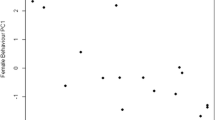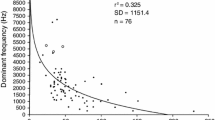Abstract
Sex identification has been studied in several species of crustacean decapods but only seldom was the role of multimodality investigated in a systematic fashion. Here, we analyse the effect of single/combined chemical and visual stimuli on the ability of the crayfish Procambarus clarkii to identify the sex of a conspecific during mating interactions. Our results show that crayfish respond to the offered stimuli depending on their sex. While males rely on olfaction alone for sex identification, females require the combination of olfaction and vision to do so. In the latter, chemical and visual stimuli act as non-redundant signal components that possibly enhance the female ability to discriminate potential mates in the crowded social context experienced during mating period. This is one of the few clear examples in invertebrates of non-redundancy in a bimodal communication system.



Similar content being viewed by others
References
Acquistapace P, Aquiloni L, Hazlett BA, Gherardi F (2002) Multimodal communication in crayfish: sex recognition during mate search by male Austropotamobius pallipes. Can J Zool 80:2041–2045
Ameyaw-Akumfi C, Hazlett BA (1975) Sex recognition in the crayfish Procambarus clarkii. Science 190:1225–1226
Aquiloni L, Gherardi F (2008a) Assessing mate size in the red swamp crayfish Procambarus clarkii: effects of visual versus chemical stimuli. Freshw Biol 53:461–469
Aquiloni L, Gherardi F (2008b) Mutual mate choice in crayfish: large body size is selected by both sexes, virginity by males only. J Zool 274:171–179
Aquiloni L, Gherardi F (2008c) Evidence of cryptic mate choice in crayfish. Biol Lett 4:163–165
Aquiloni L, Buřič M, Gherardi F (2008) Crayfish females eavesdrop on fighting males before choosing the dominant mate. Curr Biol 18:462–463
Atema J, Steinbach MA (2007) Chemical communication and social behaviour of the lobster Homarus americanus and other decapods. In: Duffy JE, Thiel M (eds) Evolutionary ecology of social and sexual systems. Oxford University Press, Oxford, UK, pp 116–190
Bamber SD, Naylor E (1996) Chemical communication and behavioural interaction between sexually mature male and female shore crabs (Carcinus maenas). J Mar Biol Assoc UK 76:691–699
Bamber SD, Naylor E (1997) Sites of release of putative sex pheromone and sexual behaviour in female Carcinus maenas (Crustacea: Decapoda). Est Coastal Shelf Sci 44:195–202
Bechler DL (1995) A review and prospectus of sexual and interspecific pheromonal communication in crayfish. Freshwater Crayfish 8:657–667
Bouwma P, Hazlett BA (2001) Integration of multiple predator cues by the crayfish Orconectes propinquus. Anim Behav 61:771–776
Bushmann PJ (1999) Concurrent signals and behavioral plasticity in blue crab (Callinectes sapidus Rathbun) courtship. Biol Bull 197:63–71
Bushmann PJ, Atema J (1997) Shelter sharing and chemical courtship signals in the lobster Homarus americanus. Can J Fish Aquat Sci 54:647–654
Bushmann PJ, Atema J (2000) Chemically mediated mate location and evaluation in the lobster, Homarus americanus. J Chem Ecol 26:883–899
Caskey JL, Bauer RT (2005) Behavioral tests for a possible contact sex pheromone in the caridean shrimp Palaemonetes pugio. J Crust Biol 25:35–40
Christofferson JP (1970) Evidence for the controlled release of a crustacean sex pheromone. J Chem Ecol 4:633–639
Corotto FS, Bonenberger DM, Bounkeo JM, Dukas CC (1999) Antennule ablation, sex discrimination, and mating behavior in the crayfish Procambarus clarkii. J Crustacean Biol 19:708–712
Cowan DF (1991) The role of olfaction in courtship behavior of the American lobster Homarus americanus. Biol Bull 181:402–407
Cronin TW, Hariyama T (2002) Spectral sensitivity in crustacean eyes. In: Wiese K (ed) The crustacean nervous system. Springer, Berlin, pp 499–511
Dawkins MS (1995) Unravelling animal behaviour. Longman, Harlow
Díaz ER, Thiel M (2004) Chemical and visual communication during mate searching in rock shrimp. Biol Bull 206:134–143
Dunham DW, Oh JW (1992) Chemical sex discrimination in the crayfish Procambarus clarkii: role of antennules. J Chem Ecol 18:2363–2372
Dunham DW, Oh JW (1996) Sex discrimination by female Procambarus clarkii (Girard, 1852) (Decapoda, Cambaridae): use of chemical and visual stimuli. Crustaceana 69:534–542
Forbes MRL, Pagola H, Baker RL (1992) Causes of a non-random pairing by size in the brine shrimp, Artemia salina (Crustacea: Anostroca). Oecologia 91:214–219
Galeotti P, Ruolini D, Fea G, Ghia D, Nardi PA, Gherardi F, Fasola M (2006) Cryptic female choice in a freshwater crayfish: females produce larger eggs for small, large-clawed males. Proc R Soc Lond B 273:1105–1110
Gherardi F (2006) Crayfish invading Europe: the case study of Procambarus clarkii. Mar Freshw Behav Physiol 39:175–191
Gherardi F, Raddi A, Barbaresi S, Salvi G (1999) Life history patterns of the red swamp crayfish, Procambarus clarkii, in an irrigation ditch in Tuscany. In: von Vaupel Klein JC, Schram FR (eds) The biodiversity crisis and Crustacea. Balkema, Rotterdam, pp 99–108
Gherardi F, Renai B, Galeotti P, Rubolini D (2006) Nonrandom mating, mate choice, and male–male competition in the crayfish Austropotamobius italicus, a threatened species. Arch Hydrobiol 165:557–576
Goshima S, Koga T, Murai M (1996) Mate acceptance and guarding by male fiddler crabs Uca tetragonon (Herbst). J Exp Mar Biol Ecol 196:131–143
Guilford T, Dawkins MS (1991) Receiver psychology and the evolution of animal signals. Anim Behav 42:1–14
Hazlett BA (1985) Chemical detection of sex and condition in the crayfish Orconectes virilis. J Chem Ecol 11:181–189
Hughes M (1996a) The function of concurrent signals: visual and chemical communication in snapping shrimp. Anim Behav 52:247–257
Hughes M (1996b) Size assessment via a visual signal in snapping shrimp. Behav Ecol Sociobiol 38:51–57
Huner JV, Barr JE (1991) Red swamp crawfish: biology and exploitation, 3rd edn. Sea Grant College Program, Baton Rouge, Louisiana
Immelmann K, Beer C (1989) A dictionary of ethology. Harvard University Press, Cambridge, p 106
Itagaki H, Thorp JH (1981) Laboratory experiments to determine if crayfish can communicate chemically in a flow-through system. J Chem Ecol 7:115–126
Kamio M, Matsunaga S, Fusetani N (2000) Studies on sex pheromones of the helmet crab, Telmessus cheiragonus 1. An assay based on precopulatory mate-guarding. Zool Sci 17:731–733
Kasuya E, Tsurumaki S, Kanie M (1996) Reversal of sex roles in the copulatory behavior of the imported crayfish Procambarus clarkii. J Crustacean Biol 16:469–471
Nobblitt SB, Payne JF, Delong M (1995) A comparative study of selected physical aspects of the eggs of the crayfish Procambarus clarkii (Girard, 1852) and P. zonangulus (Hobbs and Hobbs, 1990) (Decapoda, Cambaridae). Crustaceana 68:575–582
Partan S, Marler P (1999) Communication goes multimodal. Science 283:1272–1273
Partan S, Marler P (2005) Issues in the classification of multimodal communication signals. Amer Natural 166:231–245
Pavey CR, Fielder DR (1996) The influence of size differential on agonistic behaviour in the freshwater crayfish, Cherax cuspidatus (Decapoda, Parastacidae). J Zool 238:445–457
Quinn DGP, Keough MJ (2002) Experimental design and data analysis for biologists. Cambridge University Press, Cambridge, p 556
Rowe C (1999) Receiver psychology and the evolution of multicomponent signals. Anim Behav 58:921–931
Scheffer SJ, Uetz GW, Stratton GE (1996) Sexual selection, male morphology, and the efficacy of courtship signalling in two wolf spiders (Aranae: Lycosidae). Behav Ecol Sociobiol 38:17–23
Siegel S, Castellan NJ (1988) Nonparametric statistics for the behavioural sciences. McGraw-Hill, New York
Simon JL, Moore PA (2007) Male–female communication in the crayfish Orconectes rusticus: the use of urinary signals in reproductive and non-reproductive pairings. Ethology 113:740–754
Sneddon LU, Huntingford FA, Taylor AC, Clare AS (2003) Female sex pheromone-mediated effects on behavior and consequences of male competition in the shore crab (Carcinus maenas). J Chem Ecol 29:55–70
Snyder MJ, Ameyaw-Akumfi C, Chang ES (1993) Sex recognition and the role of urinary cues in the lobster, Homarus americanus. Mar Behav Physiol 24:101–116
Stebbing PD, Bentley MG, Watson GJ (2003) Mating behaviour and evidence for a female released courtship pheromone in the signal crayfish Pacifastacus leniusculus. J Chem Ecol 29:465–475
Villanelli F, Gherardi F (1998) Breeding in the crayfish, Austropotamobius pallipes: mating patterns, mate choice and intermale competition. Freshwater Biol 40:305–315
Wisenden BD, Stacey NE (2005) Fish semiochemicals and the evolution of communication networks. In: McGregor PK (ed) Animal communication networks. Cambridge University Press, Cambridge, pp 540–567
Acknowledgement
We are grateful to three anonymous referees for their helpful suggestions. The study complies with the Italian laws of animal treatment in research.
Author information
Authors and Affiliations
Corresponding author
Rights and permissions
About this article
Cite this article
Aquiloni, L., Massolo, A. & Gherardi, F. Sex identification in female crayfish is bimodal. Naturwissenschaften 96, 103–110 (2009). https://doi.org/10.1007/s00114-008-0458-9
Received:
Revised:
Accepted:
Published:
Issue Date:
DOI: https://doi.org/10.1007/s00114-008-0458-9




